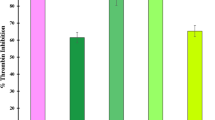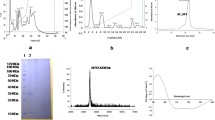Abstract
The process of blood coagulation is protecting organism from blood loss in case of surface injuries, and is ensuring blood circulation without formation of thrombus. The abnormal functioning of haemostasis is resulting in a many diseases in the recent years. Several serine proteinases and their inhibitors have a very important role in the process of the blood coagulation and are a strong potential alternative for the prevention and treatment of such illnesses. Herein, we report on anticoagulant activity, according to APTT of newly synthesized amide analogues of isoforms 2 and 3 of antistasin. Our study reveals that the replacement of carboxyl with amide function in a C-terminus of peptides is leading to significant increase of the anticoagulant activity. Additionally, some kinetic investigations on the same analogues are done. Our results show that both free acids and amides shortened analogues have a mixed type of inhibition related to serine proteinases from the blood coagulation cascade. The calculated Ki values for the model and the investigated serine proteinases show some selectivity of analogue Phe-Ile-Arg-Pro-Lys-Arg-NH2. The obtained kinetic data correlates with the anticoagulant activity of the newly synthesized analogues.

Similar content being viewed by others
References
Alban S (2008) Pharmacological strategy for inhibition of thrombin activity. Curr Pharm Des 14:1152–1175
Atanasov A, Tchorbanov B (2009) Synthetic and natural peptides as antithrombotic agents—a view on the current development. Biotechnol Biotechnol Equip 23:1109–1114
Bajusz S, Szell E, Bagdy D et al (1990) Highly active and selective anticoagulants: d-Phe-Pro-Arg-H, a free tripeptide aldehyde prone to spontaneous inactivation, and its stable N-methyl derivative, d-MePhe-Pro-Arg-H. J Med Chem 33:1729–1735
Basanova AV, Baskova IP, Zavalova LL (2002) Vascular-platelet and plasma hemostasis regulators from bloodsucking animals. Biochemistry (Moscow) 67:143–150
Caldwell HK, Young WS III (2006) Oxytocin and vasopressin: genetics and behavioral implications. In: Lajtha A, Lim R (eds) Handbook of neurochemistry and molecular neurobiology: neuroactive proteins and peptides, 3rd edn. Springer, Berlin, pp 573–607
Clyne E, Schoofs L, Salzet M (2005) A review of the most important classes of serine protease inhibitors in insects and leeches. Med Chem Rev 2:197–206
Danalev D (2012) Inhibitors of serine proteinases from blood coagulation cascade—view on current developments. Review 12:721–730
Danalev DL, Vezenkov LT (2009) Design, synthesis and anticoagulant studies of new antistasin isoform 2 and 3 analogues, Bulgarian Chemical Communications. in: Proceedings of the 5th Bulgarian Peptide Symposium, vol. 41, pp 99–103
Danalev D, Vezenkov L, Grigorova B (2004) Synthesis and structure–activity relationship of new analogues of antistasin. J Pept Sci 10:27–36
Danalev D, Vezenkov L, Grigorova B (2005) Design, synthesis and structure–activity relationship of a series of fragment analogues of antistasin (ATS) and ghilantens (GLS). Bioorg Med Chem Lett 15:4217–4220
Danalev D, Yotova L, Vezenkov L (2006) Investigation of kinetic parameters in vitro of serine proteinases included in the blood coagulation cascade. Protein Pept Lett 13:535–537
Danalev D, Vezenkov L, Lozanov V, Bakalova A (2010) Design, synthesis and structure–activity relationship of new 109–116 fragment analogues of antistasin and ghilantens. Inter J Pept Res Ther 16:107–110
Di Nisio M, Middeldorp S, Buller HR (2005) Direct thrombin inhibitors. New Engl J Med 353:1028–1040
Dunwiddie CT, Nutt EM, Vlasuk GP, Siegl PK, Shaffer LW (1992) Anticoagulant efficacy and immunogenicity of the selective factor Xa inhibitor antistasin following subcutaneous administration in the Rhesus monkey. Thromb Haemost 67:371–376
Faria F, Kelen EM, Sampaio CA, Bon C, Duval N, Chudzinski-Tavassi AM (1999) A new factor Xa inhibitor (lefaxin) from the Haementeria depressa leech. Thromb Haemost 82:1469–1473
Fernandez AZ, Tablante A, Beguin S, Hemker HC, Apitz-Castro R (1999) Draculin, the anticoagulant factor in vampire bat saliva, is a tight-binding, noncompetitive inhibitor of activated factor X. Biochim Biophis Acta 1434:135–142
Iwanaga S, Okada M, Isawa H, Morita A, Yuda M, Chinzei Y (2003) Identification and characterization of novel slaivery thrombin inhibitors from the ixodidae tick, Haemaphysalis longicornis. Eur J Biochem 270:1926–1934
Kurzyna M, Fijałkowska A, Kuca P, Tomkowski W, Torbicki A (2000) Recombinant hirudine in suspected heparin induced thrombocytopenia—case report of pulmonary embolism. Pol Arch Med Wewn 104:785–789
Lee HJ, Macbeth AH, Pagani JH, Young WS (2009) Oxytocin: the great facilitator of life. Prog Neurobiol 88:127–151
Longrois D, de Maistre E, Bischoff N, Dopff C, Meistelman C, Angioï M, Lecompte T (2000) Recombinant hirudin anticoagulation for aortic valve replacement in heparin-induced thrombocytopenia. Can J Anesth 47:255–260
Mao SS, Przysiecki CT, Krueger JA, Cooper CM, Lewis SD, Joyce J, Lellis JA (1998) Selective inhibition of factor Xa in the prothrombinase complex by the carboxyl-terminal domain of antistasin. J Biol Chem 273:30086–30091
Markwardt F (1955) Untersuchunjen uber hirudin. Naturwissenschaften 42:537–538
Marlowe CK, Sinha U, Gunn AC, Scarborough RM (2000) Design, synthesis and structure–activity relationship of a series of arginine aldehyde factor Xa inhibitors. Part 1: structures based on the (d)-Arg-Gly-Arg tripeptide sequence. Bioorg Med Chem Lett 10:13–16
Moser M, Auerswald E, Mentele R, Eckerskorn C, Fritz H, Fink E (1998) Bdellastasin, a serine protease inhibitor of the antistasin family from the medical leech (Hirudo medicinalis)—primary structure, expression in yeast, and characterisation of native and recombinant inhibitor. Eur J Biochem 253:212–220
Nienaber J, Gaspar AR, Neitz AW (1999) Savignin, a potent thrombin inhibitor isolated from the salivary glands of the tick Ornithodoros savignyi (Acari: Argasidae). Exp Parasitol 93:82–91
Ostrem JA, Al-Obeidi F, Safar P et al (1998) Discovery of a novel, potent, and specific family of factor Xa inhibitors via combinatorial chemistry. Biochemistry 37:1053–1059
Rupin A, Mennecier P, Lila C, de Nanteuil G, Verbeuren TJ (1997) Selection of S18326 as a new potential and selective boronic acid direct thrombin inhibitor. Thromb Haemost 78:1221–1227
Smythe M, Stephens J, Koerber J, Mattson J (2005) A comparison of lepirudin and argatroban outcomes. Clin Appl Thromb Hemost 11:371–374
Stone GW, McLaurin BT, Cox DA et al (2006) Bivalirudin for patients with acute coronary syndromes. New Eng J Med 355:2203–2216
Strube KH, Kroger B, Bialojan S, Otte M, Dodt J (1993) Isolation, sequence analysis, and cloning of haemadin. An anticoagulant peptide from the Indian leech. J Biol Chem 268:8590–8595
Tuszynski GP, Gasic TB, Gasik GJ (1987) Isolation and characterization of antistasin. An inhibitor of metastasis and coagulation. J Biol Chem 262:9718–9723
Zang X, Maizels RM (2001) Serine protease inhibitors from nematodes and the arms race between host and pathogen. Trends Biochem Sci 26:191–197
Conflict of interest
All authors of this paper declare that they have no conflict of interest with any company, institutions or persons.
Author information
Authors and Affiliations
Corresponding author
Rights and permissions
About this article
Cite this article
Danalev, D., Marinkova, D., Raykova, R. et al. Kinetic Investigation and Anticoagulant Activity of Amide Analogues of Isoform 2 and 3 of Antistasin. Int J Pept Res Ther 20, 195–200 (2014). https://doi.org/10.1007/s10989-013-9381-9
Accepted:
Published:
Issue Date:
DOI: https://doi.org/10.1007/s10989-013-9381-9




